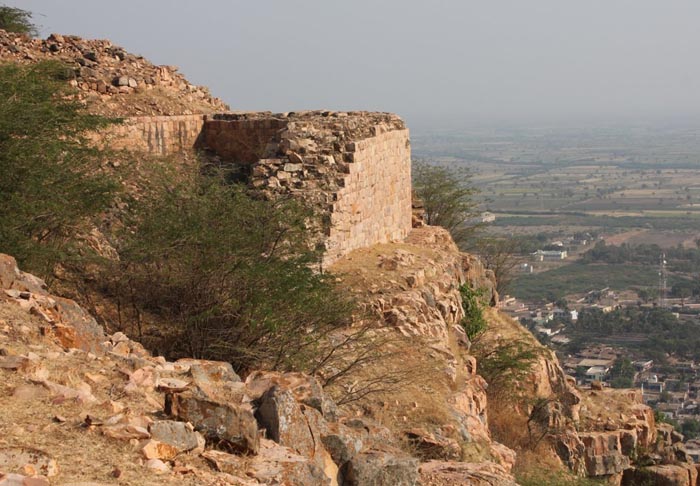Nargund Fort

Information on Nargund Fort (Gadag, Karnataka) - History & Architecture
Nargund Fort is located on a hill in Gadag district of Karnataka. The name Nargund appeared from the word 'Naragund' which signify 'hill of jackals'. It was created by famous Maratha King Chhatrapati Shivaji in 1675. Nargund Fort has ironic history and inheritance related with it. It has remained witness for various battles.
Nargund Fort Architecture
Nargund Fort was created under the administration and methodological leadership of Shivaji. It had typical attributes which were exclusive than other forts created by Maratha king Shivaji. Nargund Fort had amazing architecture. The planning of the fort was done in great details so that it become challenging for any enemy to capture it. Nargund Fort was established in order to prolong the Mughal Territory and to create a strong hold over the area. By itself, most of the area inside Nargund Fort was boarded to be used by Shivaji's army.
Unlike other historical forts in Karnataka, Nargund Fort had no sumptuous fortresses or floors. There remained no garden inside the fort. It was lacking of any sanctuary as well. The creator, Shivaji did not believed such structures as essential inside the fort and therefore, evaded wasting time and resources on its creation. Apart from ornamental components, the architecture of Nargund Fort was based on every requisite and essential aspects such as water reservoirs, ammo storage space, large well for uninterrupted water supply and watchtowers among others.
At present, the momentous Nargund Fort has become a ruined place. Most of the important structures of the fort was destroyed with time. The place has become an open field where any individual can enter easily. Nowadays, Nargund Fort is under the custody of the government of Karnataka. However, the area still rests as an unrestricted place and very few activities can be done in order to renovate the fort. Gradually, Nargund Fort is in the process to become only as a memory in history of India.
Nargund Fort History
Nargund Fort is one of the various creations of king Shivaji. It was under the authority of Maratha rulers for 15 years after its creation. Nevertheless, in 1961, Mughal king Aurangzeb invaded the fort and captured it by conquering the Maratha armies. However, the courageous Maratha armies again captured the fort form Mughal ruler under the guidance of Ramrao Dadaji Bhave in 1707.
In 18th century Nargund Fort along with the nearby region was under the authority of King Venkat Rao of Bhave family. He was underneath the leadership of Maratha ruler. Nonetheless, this supremacy of Maratha rulers on Nargund Fort sustained till the year 1778. Afterwards, the fort was assaulted and captured by the king of Mysore, Hyder Ali. In 1784, Hyder Ali's son, Tippu Sultan grasped the ownership of the fort.
Nargund Fort also played vital part during the revolt against British rulers throughout the Sepoy rebellion which occurred in 1857. On that time, the fort was controlled by Bhaskar Rao Bhave who administrated the Nargund area. He plotted an assault on British army who were approaching to the fort in order to seize it. In later phase, under the leadership of Major Malcolm, Nargund Fort was captured by British army.
Nargund Fort Tourism Importance
Although Nargund Fort has become a ruined place, it has significant historical importance which makes it a popular place for tourism. Travellers can enjoy the debris and remains of the historical fort. Furthermore, people can also observe the open field along with the hillside area which is quite tempting for travelling purposes.
- Bangalore Monuments
- Bagalkot Monuments
- Belgaum Monuments
- Bellary Monuments
- Bidar Monuments
- Bijapur Monuments
- Chitradurga Monuments
- Coorg Monuments
- Dakshina Kannada Monuments
- Gadag Monuments
- Gulbarga Monuments
- Hassan Monuments
- Mysore Monuments
- Raichur Monuments
- Uttara Kannada Monuments
- Yadgir Monuments
- Andaman Nicobar Monuments
- Andhra Pradesh Monuments
- Assam Monuments
- Bihar Monuments
- Chhattisgarh Monuments
- New Delhi Monuments
- Goa Monuments
- Gujarat Monuments
- Haryana Monuments
- Himachal Pradesh Monuments
- Jammu and Kashmir Monuments
- Karnataka Monuments
- Kerala Monuments
- Madhya Pradesh Monuments
- Maharashtra Monuments
- Odisha Monuments
- Punjab Monuments
- Rajasthan Monuments
- Tamil Nadu Monuments
- Telangana Monuments
- Uttar Pradesh Monuments
- West Bengal Monuments